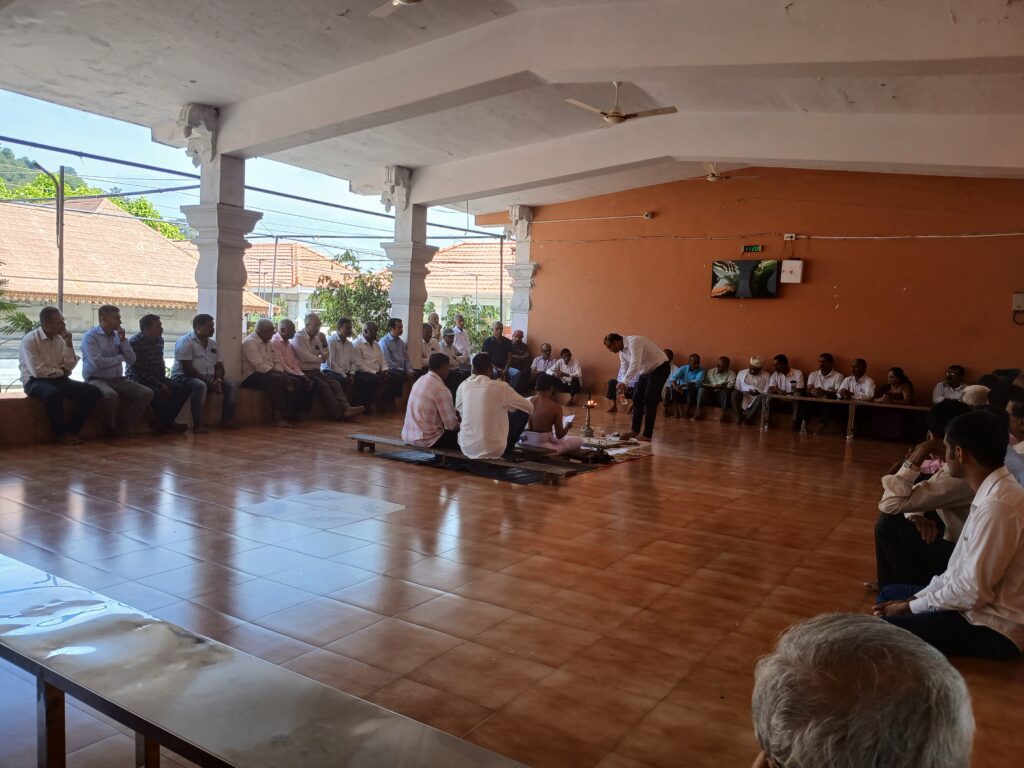
The date for Puthari has been officially announced yesterday from Padi Sri Igguthappa Temple’s Pathepare – the hall from where the auspicious date and timings are usually announced.
The Deva Thakka Paradanda Subramani Kaveriappa and other Thakkas from 12 Okkas were present with Paal Bayaad before the Namme Kuripo ceremony was started.
They announced that Puthari will celebrated Saturday, 14th December.
The auspicious timings are as under;
At the temple:-
7.30 PM – NERE KATTUVO
8.30 PM – KADD EDUPO
9.30 PM – Dinner
The timings for the people of Kodagu is recommended as 7.50 PM, 8.50 PM and 9.50 PM.
After the Nithya Pooja, a meeting presided by the Deva Thakka Paradanda Subramani Kaveriappa was held where the members expressed their views.
Pandanda Naresh said that the Deshakattu is in force from after 4 PM yesterday. It was understood that all the people celebrating Puthari, should refrain from ostentatious functions, including marriages, engagement ceremonies and so on.
Anjaparavanda Ravi Somaiah reiterated that even Mada ceremonies were normally avoided in the time frame of Deshakattu, which lasts for 15 days ending on the evening of Birchyaar Kaladcha on the 13th. He also stated that it was important to respect every aspect of our culture to ensure the prosperity of the Kodava Community.
Kundyolanda Ramesh – the Kolekeri Oor Thakka, Ketolira Sunny Somanna – Mundalenaad Aramane Thakka also reinforced the above views. Subsequently, The President of Akhila Kodava Samaja who is also President of Padi Shri Igguthappa Bhaktha Jana Sangha confirmed that “this year Puthari happens on the 14th evening when the moon enters the Muhurtam of full moon day at 4.59 PM and lasts till 2.32 PM of the 15th.
He further explained that this event of the sacred Moonlit night, also called “Waxing Gibbous” when the moon is on the rising phase and well within its climax till 2.32 PM. Coincidently, the Rohini Nakshatra also follows this auspicious time from 14th morning, 6 AM till 3 AM on 15th December. It appears that our ancestors were aware of the auspicious timing of Rohini Nakshatra, which happens at the same time. This timing is considered to be sacred and is good for fertility and prosperity of the land. He emphasized that the confusion of considering the calendar date of 15th as the “day” of full moon for considering the Muhurutam is a mistaken notion as the moon will be in a waning gibbous phase. Waning gibbous phase is not looked upon as a positive phenomena for such a sacred occasion. Our learned ancestors like Kalyata Ajjappa who was well versed in these matters followed these principles.”
Following the pooja at the temple, they proceeded to the Malma for the Katt to be effective.
The symbolic announcement of the Katt signifies that;
- There should no ostentatious social engagements like weddings, etc; performed during Puthari.
- In the past, hunting was banned during this period. So even in the present day all firearms were put away during this period.
- Typically all the families use this period for thorough cleaning of their Ainmanes, the surrounding areas, their Oor Temples and importantly the Nad Mand, in preparation for the Puthari festival.
- It is also a time when the community members get together to practice their traditional dance steps and induct and train new dancers.
Puthari is the most important festival for Kodavas, where all the communities come together for the festivities. Paradanda Subramani Kaveriappa expressed hope that this much needed community building celebration will continue in the true Kodavaame spirit of celebrating Puthari. A similar phenomenon takes place with the Onam festival in neighbouring Kerala.



The post on the Announcement of the date for Puthari is filled with information and resonates the underlying feature of The Kodava way of community building through consensus.
I was not all that focused on the actual timing and date, Rohini Nakshatra and all such “external” influences – rather the thought that Thakkas from different surrounding Okkas came together to make a joint announcement. Such consensus building features are the need of the hour that symbolizes the essence of celebrations as recounted by old timers in Kodagu. I was told by the elders that the workers employed at the estate were given new clothes, a good meal and jointly celebrated the actual event of the symbolic harvest and sacred ceremonies of bringing the Kadd to the AineMane, paying respects to the ancestors at the Kaimada, singing the ManePaat in all the individual AineManes’ in the Oor and so on. Not to mention the revelry and dancing following a good meal and some of the spirit lifting elixir – hopefully consumed responsibly!
There is a much needed revival of these practices with more families encouraging their family members to come and celebrate together. The numbers are increasing. Celebrate at one’s respective AineMane – the Kodava Samaja is NOT a substitute!